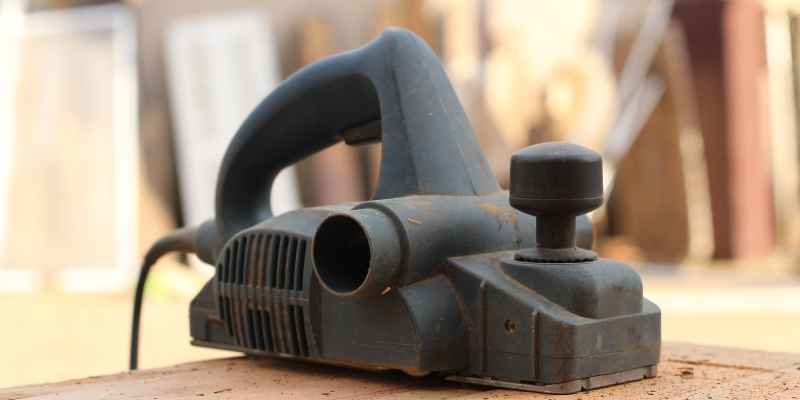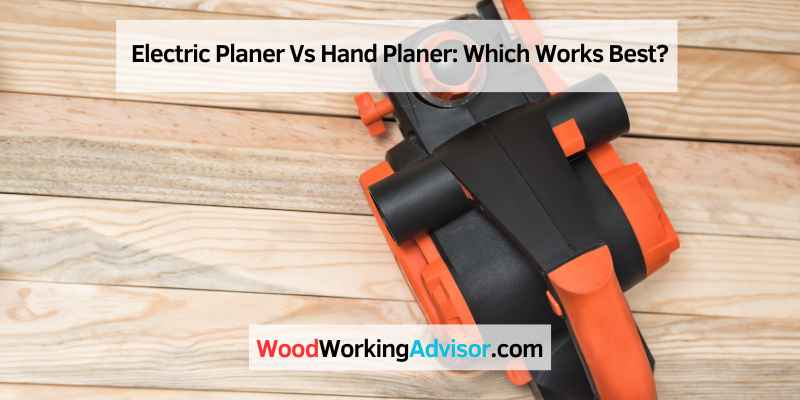An electric hand planer is more efficient for larger tasks due to its powerful motor, which allows it to work quickly and with less effort than a traditional hand planer. However, hand planers are better suited for smaller or household tasks.
While power planers are faster and have a wider sole, they can leave ripples on the surface, while hand planes take more skill and time to use, but leave minimal sanding needed. Planers are designed to flatten a board’s top and bottom, and will not give square edges or help clean up the sides of a board.
Ultimately, the choice between an electric planer and a hand planer depends on the size and complexity of the job at hand and the artisan’s own preferences.
Comparison Test: Hand Planer Vs Electric Planer

Electric planers are faster and more efficient than traditional hand planers due to their powerful motors. They can handle larger tasks and require less effort. However, hand planers are more suitable for smaller household tasks or home workshops and offer more control, but require more skill to use.
Consider the amount of work and project size when choosing between the two.
When it comes to woodworking, the debate over the best tool to use for face jointing, edge jointing, and power tools jointing has been going on for ages. Hand planers and electric planers are two of the most popular choices. Both have their advantages and disadvantages, so it’s crucial to compare their differences to determine which tool is right for you.
Methodology
To evaluate which type of planer is the best, we took a closer look at the performance of both hand and electric planers by assessing four essential tasks, including face jointing, edge jointing, power tool jointing, and the final results. We compared the results of each tool, recording the time it took to complete each task, the accuracy of the final product, and the level of ease of the tool’s use.
Face Jointing
When it comes to face jointing, both hand and electric planers can produce quality results. The primary difference lies in the effort and time required. With a hand planer, you need to make multiple passes manually, which is time-consuming and requires a lot of energy. Electric planers, on the other hand, offer a more efficient and straightforward solution. They have powerful motors that can remove material quickly and accurately.
Edge Jointing
When it comes to edge jointing, both hand planers and electric planers can produce quality results. Hand planers generally provide more control, allowing you to make precise cuts and edges. However, that precision comes at the cost of time and effort. Electric planers can produce quality edges effortlessly in less time.
Power Tools Jointing
When it comes to power tool jointing, electric planers have a clear advantage over hand planers. Electric planers are faster and more efficient, accurately removing any warp or twist in the board. Although hand planers may be functional, they require too much effort and time to compete with the speed and accuracy of electric planers.
Final Results
Overall, both hand planers and electric planers can produce quality results. Still, electric planers offer a more efficient solution, saving time and effort. For those who value precision, control, and the joy of handcrafts, hand planers remain a popular choice. However, for larger projects or those who value efficiency and speed, electric planers are an excellent choice.
In conclusion, whether you choose an electric planer or a hand planer primarily depends on the type of project, your level of expertise, and your preferences. Choosing the right planer will guarantee excellent results.
Hand Planer Vs Electric Planer: Pros And Cons
Electric planers are more efficient for larger jobs and can complete tasks more quickly than hand planers. However, hand planers are better for smaller household projects or home workshops and require more skill and time to use properly. Advantages of electric planers include wider soles and powerful motors, but they can leave ripples on surfaces if too much material is taken off at once.
Hand planers, on the other hand, require less sanding and produce smoother finishes but are slower and more skill-intensive.
When it comes to smoothing wood surfaces, both hand planers and electric planers are popular choices among woodworkers. While hand planers have been used for centuries, electric planers are relatively new advancements in power tools technology. Both have their merits and demerits, and selecting the right one often depends on the task at hand and personal preference. In this article, we’ll examine the pros and cons of hand planers and electric planers, focusing on the Advantages and Disadvantages of each one.
Advantages Of Hand Planer
A hand planer is a simple, yet versatile tool that can handle a variety of woodworking tasks. Here are some advantages of using a hand planer:
- Hand planers are portable and lightweight, making them easy to carry around and use anywhere.
- Hand planers can be adjusted to produce precise cuts and desired thickness.
- Hand planers do not produce noise or dust, making them ideal for indoor usage.
- Hand planers are inexpensive and require minimal maintenance.
Disadvantages Of Hand Planer
While hand planers may seem convenient for some woodworkers, there are also some drawbacks to using them:
- Hand planers require physical exertion and effort to get the job done, making them tiring to use for extended periods of time.
- Hand planers are slower than electric planers, which can lead to a prolonged time for completing projects.
- Hand planers require sharpening the blades regularly.
- Hand planers may produce inconsistent cuts or patterns due to human error.
Advantages Of Electric Planer
Electric planers are becoming increasingly popular among woodworkers for their ability to speed up the work process. Below are some advantages of using an electric planer:
- Electric planers are faster and more efficient than hand planers, enabling woodworkers to finish tasks quickly.
- Electric planers produce smooth, even cuts and patterns.
- Electric planers are powerful, making them ideal for tackling large projects and heavy-duty jobs.
- Electric planers require minimal physical exertion and are easy to use.
Disadvantages Of Electric Planer
While electric planers are faster and more efficient, they also have their drawbacks that cannot be overlooked. Here are some disadvantages of electric planers:
- Electric planers are usually larger and bulkier, making them difficult to carry around and store.
- Electric planers produce a lot of noise and dust, which might not be ideal for indoor usage.
- Electric planers have a higher cost and require regular servicing, making them a more significant investment compared to hand planers.
- Electric planers may produce uneven cuts if not used skillfully, leading to waste of materials.
Conclusion
In conclusion, both hand planers and electric planers have their own set of advantages and disadvantages. While some woodworkers prefer the traditional feel and control of a hand planer, others opt for the power and efficiency of an electric planer. Before deciding on which planer to use, it is essential to consider the project requirements, budget, and personal preference. Regardless of the choice, it is crucial to use the tool skillfully and safely to achieve desired results.
Electric Hand Planer Basics
Electric and hand planers serve the same purpose but differ in the method of operation. An electric planer can handle bigger tasks due to its powerful motor, while the traditional hand planer is perfect for smaller household routines or a home workshop.
Whether you’re a DIY enthusiast or a professional woodworker, you need to make the right planing choice. When it comes to planing surfaces, you have two options to choose from – electric planer or hand planer. However, in this section, we’ll talk about the basic knowledge of electric hand planers.
Blade Adjustment
When using an electric hand planer, it’s important to know how to adjust the blades. Generally, the blade adjustment knob is located at the back of the planer on the base plate. You can easily adjust the blades by loosening the lock knob and then turning the blade adjustment knob. Make sure the blades are level and properly aligned before using the planer.
Safety Tips
Safety should be your top priority when using an electric hand planer. Before starting, ensure you are wearing eye and ear protection. Use clamps or a vice to secure the wood in place and avoid holding it with your hands. Also, keep the power cord away from the path of the electric hand planer while in use.
Using The Electric Hand Planer
To use an electric hand planer, first, set the depth plate to the desired thickness of the cut. Then, turn on the planer and move it along the length of the wood, keeping it level and avoiding any sudden stops or starts. Once the first pass is made, you can repeat the process by making the next pass slightly overlapping the previous pass for accuracy. It’s important to keep the speed and pressure consistent throughout the process for best results.
In conclusion, electric hand planers are a powerful woodworking tool for all your planing needs. However, adherence to safety tips and the proper use of the blade adjustment are important for good results.
Hand Planer Vs Bench Planer
Electric planers offer faster and more efficient wood planing, while hand planers provide more control over the surface and allow for more intricate designs. Hand planers are fit for smaller households, and electric planers are better suited to larger woodworking projects.
When it comes to planing wood, you have two main options: the hand planer, which is operated manually, and the bench planer, which is powered by electricity. Each type of planer has its own set of advantages and disadvantages. In this section, we will discuss the differences between hand planers and bench planers, as well as the advantages and disadvantages of each.
Differences Between Hand Planer and Bench Planer
There are several key differences between hand planers and bench planers. The most obvious difference is that hand planers are operated manually, while bench planers are powered by electricity. Hand planers are also much smaller and more portable than bench planers, which are typically large and stationary. Hand planers are best suited for small-scale projects, while bench planers are better for larger projects that require more power and precision.
Advantages and Disadvantages of Hand Planer
Hand planers are a great choice for small-scale projects, such as trimming and shaping smaller pieces of wood. They are also very portable, which makes them ideal for carpenters who need to work on-site. However, hand planers can be quite tiring to use if you are working on a larger project. They also require a lot of skill and patience to use effectively.
Advantages and Disadvantages of Bench Planer
Bench planers are ideal for larger-scale projects, as they are powered by electricity and can handle tougher materials. They are also more precise than hand planers, thanks to their large cutting blades and adjustable depth settings. However, bench planers are quite large and heavy, which makes them less portable than hand planers. They also require a dedicated workspace, as they need to be set up and plugged in before use.
In conclusion, while both hand planers and bench planers have their own unique advantages and disadvantages, the choice ultimately comes down to your personal preferences and the scope of your project. Smaller projects that require precision and a more personal touch may benefit from the use of a hand planer, while larger, more complex projects may require the power and precision of a bench planer.
What Are The Limitations Of Handheld Power Planers?
Limitations of handheld power planers compared to electric planers? Handheld power planers are quicker and wider but can leave ripples on a surface if too much wood is removed. They are also heavier and require more skill to use. An electric planer can handle larger tasks and move more quickly with less effort, but may not provide the same level of precision as a hand planer when working on smaller projects.
Surface Ripples
One significant limitation of using handheld power planers is that they may leave behind surface ripples. These ripples can occur due to several reasons, such as uneven pressure, blade height, or feed rate. The issue with surface ripples is that they can affect the overall finish of the wood piece and make it look unprofessional. Moreover, these ripples can be challenging to remove, and if left unaddressed, can lead to further issues with the wood piece.
No Square Edges Or Clean Sides
Another limitation of handheld power planers is that they may not give square edges or clean sides. Even the slightest tilt while using the handheld power planer can result in uneven edges, making it challenging to fit the wood pieces together adequately. Moreover, the handheld power planer’s blade may not be sharp enough to provide a clean-cut, leading to splinters and rough edges. The importance of clean and square edges cannot be overstated in woodworking, and failing to achieve them can significantly affect the final result of the project.
Need For Jointer Or Table Saw
Using a handheld power planer may require additional tools like a jointer or a table saw to achieve the desired result. This can be a limitation for users who do not possess the necessary tools and may have to invest in them. The jointer and table saw are used to prepare the wood surface before using a handheld power planer. The jointer ensures that the wood’s face and edges are flat and square, while the table saw can trim the wood to size before using the handheld power planer. Depending on the project’s size, using a handheld power planer without these additional tools can lead to unsatisfactory results.
Overall, while handheld power planers are a useful tool in woodworking, they come with their limitations. Surface ripples, no square edges or clean sides, and the need for a jointer or table saw are some of the limitations that users should be aware of before using them. Understanding these limitations can help users make informed decisions and achieve better results in their woodworking projects.

Frequently Asked Questions For Electric Planer Vs Hand Planer
Is An Electric Planer Better Than A Hand Planer?
Electric hand planers are better than traditional hand planers because they have powerful motors that can handle larger tasks and move faster, making them more efficient and requiring less effort on the user’s part. However, bench planers are better for larger woodworking projects, while hand planers are better for smaller household routines or home workshops.
Power planers are quicker but can leave ripples in the surface, while hand planes are slower but require more skill.
Is A Table Top Planer Better Than A Hand Planer?
An electric planer is better than a hand planer for larger tasks due to its powerful motor and quicker movement, leading to increased efficiency and less effort. However, both hand planers and electric planers have their advantages and disadvantages, and the choice depends on the amount of work and the user’s preferences.
What Are The Advantages And Disadvantages Of A Hand Held Power Planer?
The benefit of a hand held power planer is that it is quicker and has a wider sole. However, it can leave ripples in the surface if too much is removed. A hand planer is slower but requires more skill to use, but when done properly, it needs minimal sanding.
What Are The Disadvantages Of A Planer?
The main disadvantage of a planer is that it can only flatten a board’s top and bottom, and cannot give you square edges or clean up the sides of a board. For this, you will need additional tools such as a jointer or table saw.
Additionally, power planers can leave ripples on the surface if too much material is taken off at once. Hand planers require more skill to use but can provide a smoother finish.
Conclusion
Choosing between an electric planer and a hand planer depends on the task you are performing. An electric planer is perfect for larger projects that require efficient and quick results. However, a hand planer is better suited for smaller tasks or when precision carving is necessary.
You must also consider your budget and skill level when making your decision. Ultimately, both types of planers have advantages and disadvantages that should be weighed carefully before making a decision.


